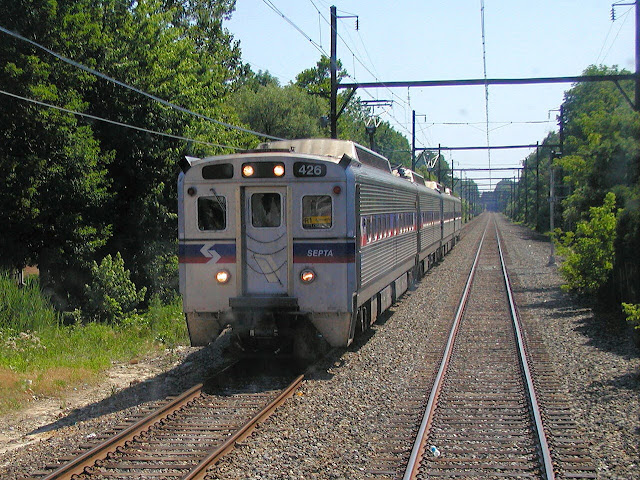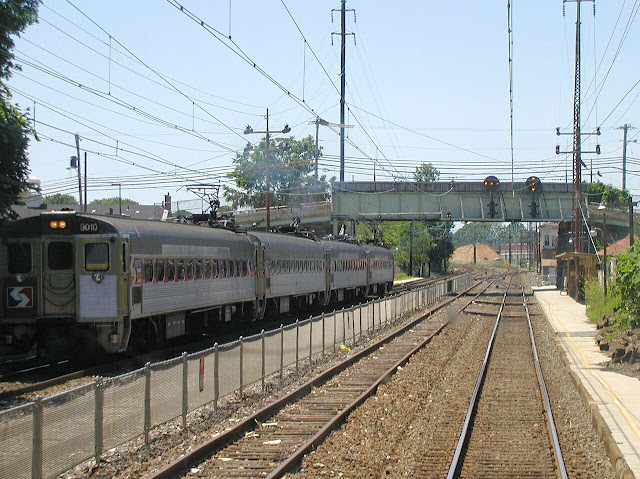In the summer of 2002 I went on a very interesting SEPTA trip with fellow local rail enthusiast Chuchubob. We traveled on SEPTA Regional Rail's R3 to the system's second most eastern station at West Trenton. From there we traveled, via Center City, to SEPTA Regional Rail's westernmost station, the somewhat new Thorndale station on the R5 line. While it is technically possible to get a through train, at the time almost all R3's and R5's would stay on their respective routings requiring a transfer at one of the downtown stations. Anyway, after waiting a headway we returned from Thorndale back to Center City. The result of all this was not only a very fun day of railfanning, but also a good number of photos on my first digital camera that I had only purchased about 6 months before. The full set of photos ( mirror ) has the distinction of having been remastered twice, first in the 2005 time period and then again in 2020 as in 2005 I was still facing photo size and editing skill constraints.
Starting things off outbound to West Trenton we pass SEPTA Silverliners IV #413 and #284 at the Roberts yard HVAC plant just prior to the doublerslip ladder at WAYNE JCT. In 2002 WAYNE tower was still open with its 1960's vintage NX-panels that controlled all of the Reading side of the Regional Rail system.
Passing the Wayne Jct electric shoppes I managed to catch SEPTA end-cab switchers #50 and $52 in the same shot. Both were END SW1200's that were rebuilt to varying degrees with #50 getting a entirely new engine at Brookville Equipment.

The Logan Regional Rail station was still standing after having been closed in the mid-1990's. It was subsequently demolished and the tracks re-aligned.
SEPTA's NEWTOWN JCT, wher the R8 Fox Chase splits off, seen here in its
penultimate configuration with an interlocked connection to the former
Conrail Trenton Line. This connection would be removed around 2008 with
SEPTA's first SEPTAration project that would remove the need to dispatch
CSX freight trains at the cost of decreased SEPTA capacity.
At JENNKIN interlocking the former Reading New York Branch (current SEPTA Neshaminy Line) splits off the former Reading Bethlehem Branch (current SEPTA Main Line). Note the signal is displaying a "straight" clear through the fairly slow curving track to the right. This would allow premier Philly to NYC trains like The Crusader, the fastest possible route through the junction.
At the time most of the Reading half of the SEPTA RRD was running under ABS Rule 251 without cab signals. Here my outbound R3 meets its inbound counterpart led by Silverliner IV #183 near Neshaminy Falls station.
SEPTA Silverliner IV #180 at the tail end of my outbound R3 before it heads into the small yard at West Trenton. Units #101 to #188 were delivered as married pairs in 1976 for service on the former Reading Railroad territory.
After lunch at Freddie's restaurant, I went over to TRENT tower, which had closed in the mid-1990's but continued to serve as the West Trenton crew base.
At this point in time it was not uncommon to catch Silverliners II and III, then starting their last decade of service, as they made up about a quarter of SEPTA's active fleet of MU's. Walking over to the small West Trenton yard I found former Reading car #9011 leading a III and PRR II.
Our return train to Center City consisted of three Silverliners II single units with ex-PRR car #254 on the east end.
The crew spent the ~20 minute layover in the storage yard before changing ends to ex-PRR car #261 and heading out for the southbound run to Center City. In 2018 SEPTA would complete another SEPTAration to avoid sharing track with CSX freight trains between Woodburne and West Trenton, again at the cost of capacity.
Returning I got this photo of the stored Reading Blueliner car adjacent to the Robert's Yard HVAC repair shoppe.
Passing through 16TH ST JCT where the R6 Norristown splits off on the tracks to the right hand side of the photo. This junction was substantially rebuilt during the 1980's Railworks project.
Changing trains at 30th St we took a moment to visit the new parking garage overlooking the Amtrak engine facility and Penn coach yards. Brand new Amtrak HHP-8 #654 was standing near a MARC HHP-8, likely on delivery from Bombardier. Amtrak hippos were retired around 2015 with the MARC units still in service as of 2023. Also visible is Amtrak GP40TC #520 in Phase III heritage paint.
The Amtrak engine terminal had a number of Phase IV heritage painted P42DC's adjacent to at least two E60s, in their last years of service hauling long distance trains on the corridor. Also visible are a pair of NJT Arrow II's being delivered to SEPTA for use as cab cars on work trains.
Outbound to Thorndale my R5 train passed its opposite with Silverliner IV #280 leading.
Another complete train of Silverliners II at Paoli with former Reading car #9010 in the lead.
Just past PAOLI tower Sperry Rail Service doodlebug #125 sat on one of the storage tracks. These railcars are used to conduct ultrasonic rail inspections.
After crossing over at THORN tower, former Reading Silverliner IV #102 takes a break at the high level Thorndale platform.
While waiting for the eastbound departure, a westbound Amtrak Keystone train hauled by Phase IV heritage P42DC #107 passed by on track #4 with a consist of Phase III painted heritage coaches. The Amtrak CEO at the time (Warrington?) had deployed the previously retired 1940's and 50's vintage Budd built stainless steel cars to Keystone trains to alleviate an acute equipment shortage.
Heading back to Philly I caught yet another Silverliner II consist in the Fraser lauup track with #218 leading.
At Paoli the westbound Pennsylvanian was going through with P40DC #40 leading a second one behind. You can see the different between the early and late style Phase V schemes in terms of the position and thickness of the red stripe.
After passing the 5th train of Silverliners II near Narberth, we found the 16L signal at OVERBROOK, another of the Harrisburg Line's manned towers, displaying Clear.
Another Clear signal at ZOO interlocking on the double cantilever mast with the Art Museum in the background.
Two former Reading Silverliners IV, #137 and #139, at Powelton yard near 30th St station. At this time the Reading operated cars could be told apart by the use of small cowcatchers instead of a bar pilot.
Of course we had to pass one additional Silverliner II consist on final approach to Suburban Station. The number is not visible, but we know it is a 9000 series Reading car again because of the cowcatcher placed ahead of the leading wheels.
Well I hope you enjoyed these classic photos. Lots of great stuff that's not there anymore.




























No comments:
Post a Comment